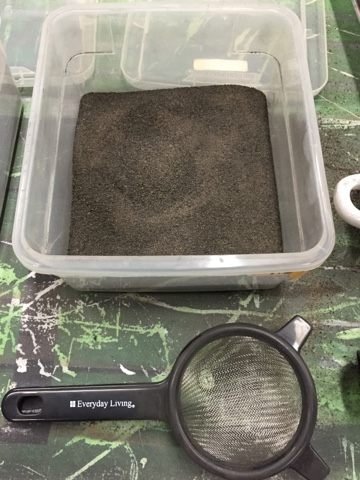Merger & Acquisiton
Rumor has it Michigan Interstate parent company Lakes Interstate Transportation Group has placed a takeover bid of the Natchez Trace & Orient parent railroad and its subsidiaries. Officials were quoted "These guys are a good fit in helping us create the Great Lakes, Gulf, & Orient Railroad, their current leadership team will help bring together two great railroads and create an competitor to rival current class 1s". When asked how they would connect between Indiana and the southeast an official was quoted "We will just buy someone else to fit the mileage gap".
Making Ground Dirt
When starting scenery I choose to make my own dirt after reading Pelle Soeberg experience. The process is pretty straight forward and inexpensive, so I want to share my process. If you are looking to do something like this, i hope this brings some inspiration or instruction.
- Step 1 (Base Material)
You can use backyard dirt or in this case I used a $1.50 bag of topsoil for a dark color from Home Depot. Originally I had dirt from Michigan but ran out, this was a close match.
- Step 2 (Basic Screening)
Color is great but a lot of extra stuff I need to sort out from the start. This is a actually two window screens that I spoon the dirt onto and sift out large items such as wood and rocks.
- Step 3 (Baking the dirt)
After basic screening the dirt falls onto a disposable aluminum baking pan where I spread a thin layer to bake. I bake 4 pans at a time, use something disposable versus the wifes good pans. I bake the dirt at 400 degrees for 30 minutes to kill off anything. Additionally the baking dries out the dirt making it perfect to sift for model railroad use.
- Step 4 (Coarse Sift)
Using a coarse sifter I spoon the dirt from pan into sifter. You can these sifters from any Walmart or grocery store. Below is what the dirt looks like after. I will run the material through the sifter a few times to get out the larger chunks, but it is up to.
At this point I keep a bucket of coarse material for basic scenic base use. I also sift the material finer for other scenic uses.
- Step 5 (Fine Sift)
Using a tea strainer this is what the fine sifted material looks like. It is very fine perfect for using in dirt road, paths, or accenting ground foams.
- Step 6 (Placement)
Once sifted time to apply with white glue or scenic cement as your base scenery layer. The dirt helps add a lot of texture and depth between ground foam/grass and the painted foam terrain.
Any questions please feel free to ask.
Vegetation Growth
Staying true to my process for scenery install, I need to had one more set of cornfields to install before I can complete the dirt material and ballast. Once this later is in, we will go wet-wet with scenic cement to add foliage, grasses, and foam ground covers.
Scenicing material being mocked up on overpass embankment at Grays Lake. Will blend in with foam grasses and flocking material. Along the backdrop to the left of the corn a small group of trees will help add depth to the scene.
Ironically making this scene green corresponds to Spring here in Texas. Stay tuned as this month we will get the last bit of corn installed and dive head first into full scenery between Grays Lake and Gerhard.
- Have a great weekend.
GM









GLGO....Will that fit on a G&W logo? HA!
ReplyDelete